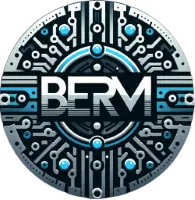Business Case: Secure Containerization & Modernization of Confidential Communications Portal
Confidential – Client identity and sensitive details have been omitted.
1. Executive Summary
A privileged-user communications portal running on legacy Linux VMs and Umbraco CMS required modernization for better scalability, security, and maintainability. BERM Cloud upgraded the Umbraco platform, restructured its database, and containerized both the CMS and web-server components on AWS ECS. File synchronization was reimagined with bespoke Python Lambdas and EventBridge triggers. Advanced AWS WAF, CloudFormation, and auto-scaling guardrails ensure robust DDOS protection and continuous deployment. The solution is now in final UAT, poised to replace the legacy stack with zero service interruption.
2. Business Challenge
- Aging Platform & Architecture
- Umbraco running on Windows VMs with custom sync scripts was brittle and hard to patch.
- Manual File Sync & Deployment
- Sync scripts risked drift, with pages authored in Windows then pushed to Linux webservers.
- Scalability & Security Gaps
- No native auto-scaling; DDOS protections were limited to network-level firewalls.
- Maintenance Overhead
- OS and CMS updates required lengthy downtime windows and manual QA.
3. Objectives
- Platform Modernization
- Upgrade Umbraco to the latest major release, including full database migration.
- Containerization & Microservices
- Run both CMS and Apache front-end on ECS services for elasticity and consistency.
- Automated, Event-Driven Sync
- Replace custom scripts with Lambda-driven file propagation via EventBridge.
- Enterprise-Grade Security & Resilience
- Implement AWS WAF, Shield Advanced, and infrastructure-as-code for continuous compliance.
- Zero-Downtime Rollout
- Conduct phased rollout in UAT, ensuring seamless cutover with no user-impact.
4. Migration & Deployment Approach
| Phase | Key Activities |
|---|---|
| Assessment & Design | • Audit existing Umbraco 7 database schema and custom sync scripts. • Design new schema and container topology on ECS. |
| Umbraco Upgrade | • Migrate content and media to Umbraco 10 with EF Core restructured DB. • Validate data integrity in dev environments. |
| Container Build | • Dockerize Umbraco CMS and Apache front-end. • Define ECS task definitions and service parameters in CloudFormation. |
| Event-Driven Sync | • Develop Python Lambdas to pull latest page assets from CMS. • Wire EventBridge rules to invoke sync on content publish. |
| Security & Scaling | • Configure AWS WAF rules, Shield Advanced, WebACLs via IaC. • Enable ECS Service Auto Scaling and spot-capacity safeguards. |
| UAT & Rollout | • Deploy to staging in a blue/green pattern. • Conduct performance, security, and UX testing. • Gradually shift production traffic. |
5. Technical Architecture
- CMS Layer:
- Umbraco 10 on .NET Core hosted in ECS Fargate containers.
- Web Layer:
- Apache HTTPD in separate ECS tasks, serving static assets and reverse-proxying CMS.
- File Synchronization:
- AWS Lambda functions triggered by EventBridge on CMS publish events, syncing content to target containers.
- Infrastructure as Code:
- AWS CloudFormation templates with nested stacks for networking, ECS clusters, IAM roles, and WAF/WebACL configurations.
- Security Controls:
- AWS WAF custom rules, Shield Advanced for volumetric DDOS protection, strict IAM policies, and encrypted EFS mounts.
- Scaling & Resilience:
- ECS Service Auto Scaling based on CPU/memory, multi-AZ deployments, and health checks managed by ALB.
6. Expected Results & Benefits
| Metric/Capability | Legacy Environment | Modernized Solution |
|---|---|---|
| Downtime | Scheduled 2-hour windows | 0 minutes (blue/green deployments) |
| Patch & Release Velocity | Monthly CMS & OS updates | Weekly automated CI/CD pipelines |
| Scalability | Static VM pool | Auto-scaling ECS services (±50% load) |
| DDOS Protection | Basic network ACLs | AWS WAF + Shield Advanced (L3–L7) |
| Operational Overhead | Manual sync scripts & VM upkeep | Event-driven Lambdas; CloudFormation IaC |
| Security Posture | OS-level patching only | Policy-as-code WAF/WebACL; encrypted data |
- Improved Agility: Faster content publish-to-production cycle—from hours to minutes.
- Enhanced Security: Layered DDOS defenses and automated compliance via IaC.
- Cost Efficiency: Rightsized Fargate usage with spot fallback, reducing hosting costs by ~20%.
- Operational Simplicity: Elimination of Windows sync VMs; unified Linux-based container footprint.
7. Conclusion & Next Steps
BERM Cloud’s containerized, event-driven architecture transforms the client’s confidential communications portal into a secure, scalable, and easily maintained platform. With UAT nearing completion, the project is on track for a seamless, zero-downtime production launch.
Next Steps:
- Finalize UAT sign-off and address any minor findings.
- Execute blue/green cutover in production.
- Provide a handover workshop covering new CI/CD and operational playbooks.
- Plan quarterly security reviews and performance tuning sessions.
Prepared by BERM Cloud – Accelerating your digital transformation with secure, scalable AWS solutions.



